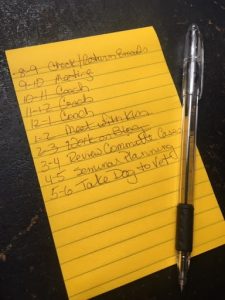Getting Motivated
By an Academic Coach
“I have a hard time motivating myself to write.” “I struggle to find the motivation to sit down and study.” As an academic coach, I hear these comments countless times from students. If I had the one infallible solution for how to motivate students to write and learn, I’m sure I would be a much sought after speaker, could go on a world-wide tour, and eventually would retire among the rich and famous! Unfortunately, I don’t think that’s quite how it is going to work.
Honestly, until now, I’ve never really put much thought or effort into how I motivate myself to write and learn. I have spent most of my career working with others on how to motivate themselves. So, taking this moment to self-reflect is not only long overdue but also pretty enlightening. For me, what I have learned without a doubt is that to motivate myself to write, I have to “get in the mood” and to motivate myself to learn I have to “get in the zone.” What insight! That alone feels like success! But an obvious question remains: “How do I get into the mood and zone?”
Clearly this question requires some deeper digging. Here’s what I uncovered:
1. I’m more motivated if I PLAN AHEAD. This may not seem like a super extraordinary find, but I find it extremely helpful. I think about when I’m going to sit down to write or learn. Maybe there’s an empty two-hour block in my schedule tomorrow morning that would be a great time to seize. The point is, I tend to be more motivated if I have planned for when I will get it done. Planning ahead takes the guesswork out of when I will work, and it gives the task a space in my daily schedule. This kind of preparation makes it harder for me to avoid work and, in turn, helps me be motivated to sit down and do it. I tend to plan in one-hour blocks, so a format such as The Learning Center’s 60-Minute Weekly Planner works well for me.
 I also get other things out of the way, essentially clearing the deck for my energy and attention to be devoted to the writing or learning task at hand. This may mean putting a load of laundry in the washer, responding to several emails, checking Instagram, paying a bill, and making a to-do list for the day before I sit down to work. That way, those things are not distracting me or pulling me away from the work I need to do. This helps me get in the zone.
I also get other things out of the way, essentially clearing the deck for my energy and attention to be devoted to the writing or learning task at hand. This may mean putting a load of laundry in the washer, responding to several emails, checking Instagram, paying a bill, and making a to-do list for the day before I sit down to work. That way, those things are not distracting me or pulling me away from the work I need to do. This helps me get in the zone.
I also make sure my work space has what I need: pens, pencils, paper, laptop, sticky notes (I LOVE sticky notes of all shapes, colors, and sizes), books, and so on. You get the picture. I am more likely to work when I have all the things I need to work.
Especially for writing, I think ahead about ideas for what I want to write. Sometimes I might jot down some ideas or a brief outline, but more often I just tend to brainstorm internally while doing other things like preparing a meal or cleaning the house. To help me remember my ideas, I frequently use the Notes app on my phone to quickly type or dictate some ideas so that I can remember them later. Because I almost always have my phone with me, this is a really easy and convenient way to record my thoughts. By doing this thinking ahead, I already have ideas about what I want to write, and this helps me get in the zone more quickly and more easily.
2. One of the biggest insights during this self-reflection process is how much my SURROUNDINGS affect my motivation and help me get in the mood. The surroundings  I’m talking about involve most of the senses. Imagine this: It’s first thing in the morning, and I settle down into my comfortable desk chair (touch) at my desk overlooking a large window where I can see a plethora of hot pink (one of my favorite colors) knockout roses in bloom (sight) and hear the multiple cardinals and robins chirping away to greet the day (hearing), all while I am enjoying a great cup of coffee (taste and smell). This is a feel-good space for me that prompts complete sensory input. And remember, my desk already has all the things I need to work, so in this scenario I have two strongly motivating forces working for me.
I’m talking about involve most of the senses. Imagine this: It’s first thing in the morning, and I settle down into my comfortable desk chair (touch) at my desk overlooking a large window where I can see a plethora of hot pink (one of my favorite colors) knockout roses in bloom (sight) and hear the multiple cardinals and robins chirping away to greet the day (hearing), all while I am enjoying a great cup of coffee (taste and smell). This is a feel-good space for me that prompts complete sensory input. And remember, my desk already has all the things I need to work, so in this scenario I have two strongly motivating forces working for me.
 Or here’s another scenario. It’s early afternoon, and the Dave Matthews Band is playing in the background through the wireless speaker. I am at the same desk, which has some of my favorite things on it (a flowering plant, a picture of family, a small original artwork in my favorite color–purple), and I have wasabi soy almonds and a diet coke by my side. Although it’s 90 degrees outside, my sweatshirt is thrown over the back of my chair ready to be worn at a moment’s notice due to the two air vents above blasting cold air down on me. I am motivated to be here and work, having all the things I need for a while. If I really need to crank out the work, I might opt to listen to the Mamma Mia movie soundtrack or Mumford and Sons, both of which tend to increase my work speed and productivity!
Or here’s another scenario. It’s early afternoon, and the Dave Matthews Band is playing in the background through the wireless speaker. I am at the same desk, which has some of my favorite things on it (a flowering plant, a picture of family, a small original artwork in my favorite color–purple), and I have wasabi soy almonds and a diet coke by my side. Although it’s 90 degrees outside, my sweatshirt is thrown over the back of my chair ready to be worn at a moment’s notice due to the two air vents above blasting cold air down on me. I am motivated to be here and work, having all the things I need for a while. If I really need to crank out the work, I might opt to listen to the Mamma Mia movie soundtrack or Mumford and Sons, both of which tend to increase my work speed and productivity!
Sometimes I may chew a piece of mint flavored gum, which seems to keep me alert and centered. I’ve had some success as well with writing when sitting outside on a warm summer night surrounded by the sounds of crickets, the humidity of a North Carolina summer, the warm glow of the overhead string lighting, the aroma of the burning Sea Salt Waves candle, and the dance of the fireflies throughout the yard. Talk about mood! What a serene and natural space to let those creative juices flow!
So, for me, this rather unconscious staging of my surroundings really increases my motivation to work by getting me in the work mood and keeping me in the work zone. In my college days, my surrounding of choice was usually the middle or upper floors of Davis Library where it was relatively quiet, where I would find a chair in a nook, and where I could study in solitude.
 3. I tend to be more motivated if I SET A GOAL. I know, I know, once again, this sounds so boring and overused, but for me, it works. I might set a certain amount of time. For example, today I designated one hour from 10 to 11 a.m. to work on this post. Sometimes, my goal is to work until a certain amount of work is done. I have historically had a lot of report writing to do, and my goal might be to complete one report during a given work session. These are rather small goals, but, for me, reaching them and crossing them off of my to-do list is hugely rewarding and motivating. The sense of both relief and accomplishment keeps motivating me to come back for more!
3. I tend to be more motivated if I SET A GOAL. I know, I know, once again, this sounds so boring and overused, but for me, it works. I might set a certain amount of time. For example, today I designated one hour from 10 to 11 a.m. to work on this post. Sometimes, my goal is to work until a certain amount of work is done. I have historically had a lot of report writing to do, and my goal might be to complete one report during a given work session. These are rather small goals, but, for me, reaching them and crossing them off of my to-do list is hugely rewarding and motivating. The sense of both relief and accomplishment keeps motivating me to come back for more!
I must admit, however, that many times my goals are somewhat unreasonable because I tend to pack too much into one day or into one space of time. But that’s OK because I still find a sense of accomplishment with what I have completed. And with my Plan Ahead tactic, I may move whatever I didn’t quite complete to another spot in the day or put it on the next day’s plan. It boils down to setting a goal and making progress on that goal while remaining flexible.
 Using this metacognitive strategy and self-reflection has been really useful for better understanding what I need to help me be motivated and stay motivated. I need to get in the mood and zone and stay there for a while, and apparently getting in the mood or zone is not the same every time. (Did I mention that I sometimes stretch out on a comfy leopard-print chair and ottoman covered by my lap desk and laptop complete with my to-do list of goals for that work session scribbled on a sticky note? I am munching on chocolate drizzled popcorn, drinking water out of my favorite UNC tumbler, and listening only to the soft snore of my lab mix dog.)
Using this metacognitive strategy and self-reflection has been really useful for better understanding what I need to help me be motivated and stay motivated. I need to get in the mood and zone and stay there for a while, and apparently getting in the mood or zone is not the same every time. (Did I mention that I sometimes stretch out on a comfy leopard-print chair and ottoman covered by my lap desk and laptop complete with my to-do list of goals for that work session scribbled on a sticky note? I am munching on chocolate drizzled popcorn, drinking water out of my favorite UNC tumbler, and listening only to the soft snore of my lab mix dog.)
I think the differences in the scenarios are largely related to the task at hand. For example, sometimes I really need to be at a table where I can spread out and have plenty of room to work. In this scenario, if I am in cramped quarters with little tabletop space, I am much less likely to be motivated to stay there and get the work done.
Even with thoughtful planning, good surroundings, and specific goals, sometimes things don’t go as planned, and my motivation is lacking or totally nonexistent. It just happens sometimes and can definitely be frustrating! In such cases, I try to practice self-kindness, acknowledge that this will happen from time to time, and then look forward to planning when or where I can try it again. There are other times when a deadline is fast approaching, and the deadline itself serves as my motivator. Although this is not my preferred method of motivation, during these times I push myself to buckle down and get work done.
Maybe you will also find it helpful to take a few minutes or more to intentionally think about what it is that motivates you to write and learn. What you uncover will likely be totally different than mine, as it should be! The point is to dig into your preferences and patterns to uncover what motivates YOU to write and learn.
This blog showcases the perspectives of UNC Chapel Hill community members learning and writing online. If you want to talk to a Writing and Learning Center coach about implementing strategies described in the blog, make an appointment with a writing coach or an academic coach today. Have an idea for a blog post about how you are learning and writing remotely? Contact us here.


